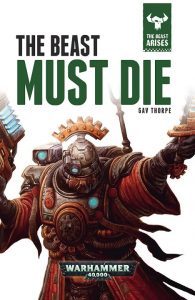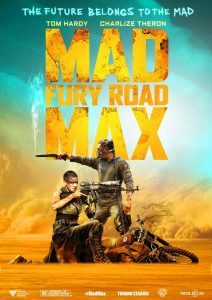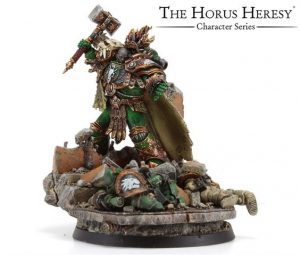The Beast Must Die – Author’s Notes
 ********
********
Spoilers! If you haven’t finished book seven in The Beast Arises series yet, you might want to bookmark this page to come back to later. You have been warned…
********
Recently I wrote an article regarding how to write a novel that is part of a continuing series but also has a distinct story in its own right. That was very much the case when it came time to write The Beast Must Die for The Beast Arises.
It’s quite straightforward to contrast my experience with The Emperor Expects and The Beast Must Die. Put simply, a lot can happen in 200,000 words! The number of plot threads and character arcs going into Book 3 was small – Grand Master Vangorich and Inquisitor Wienand, Koorland and his companions, and a few sub-plots. By the time we get to Book 8 this has exploded with threads involving Mars, Iron Warriors, multiple Chapter Masters and, quite significantly, Vulkan.
There was a lot to absorb in terms of plot and characterisation but I had one advantage over some of the other authors penning titles in the latter parts of the series and that came from the editors’ brief for the book. The Beast Must Die is almost 100% focussed on a single thread of the story – the first battle of Ullanor. While other events unfold, the book zooms in on one very specific incident, being the Imperium’s response to the revelation that the Beast has been launching its attack from Ullanor, believed wiped of the orks during the last days of the Great Crusade.
So the bulk of the book concentrates on the space marine characters – Koorland, Thane and Bohemond in particular – and through their viewpoints and a couple of new arrivals from the Adeptus Mechanicus and Astra Militarum we see events on the ork world unfold. It is a pivotal moment in the whole series, a narrative fulcrum upon which turns the remaining story.
 Full Throttle
Full Throttle
One thing that was clear from the outset was that the story was going to be action-heavy, revolving around a single huge campaign to eliminate the Beast. It was important to me that we didn’t just end up with 50,000 words of fighting without any internal conflicts and character progression that we would expect in any other story.
I took my cue from Mad Max – Fury Road and got my head round the ideas of ‘action as narrative’. Quite often, particularly in blockbuster films, action takes place between the scenes that tell the story of the characters. We have set-pieces sprinkled throughout the narrative pillars to provide eye-candy that only advance the plot a little but don’t really tell us anything about the characters. In contrast, the battles of The Beast Must Die are non-stop, like Fury Road, and through that near-constant action we learn what we need to know about the characters, their plans and motivations. They are space marines, after all, and often their weapons do the talking.
(In particular I greatly enjoyed writing about Bohemond and the Black Templars as they transition towards embracing their faith in the Emperor at odds with the secular Chapters around them.)
 The Primarch in the Room
The Primarch in the Room
The other major factor that had to be taken into account was the present of Vulkan, Primarch of the Salamanders. Now, I’ve had a bit of experience with Primarchs in the Horus Heresy series, but it was important that Vulkan was presented in a different context for the 32nd Millennium.
Here we have a character that has literally seen the Imperium since its inception, from the glory days of the Great Crusade, through the darkness of the Heresy Wars, and into the institution it has become 1,500 years later. Fans often speculate what the Emperor would think of what becomes of the Imperium in the 10,000 years following his internment into the Golden Throne. Vulkan’s perspective gives us a little idea of what that might be.
The period of The Beast Arises is fascinating to explore as we see the Imperium moving away from the vision of the Emperor toward the more superstitious, religious, zealous behemoth we know and love from the 41st millennium. Vulkan stands as an example of the time and values that came before, faced with the end of everything he fought for, caught between knowing that mankind cannot be ruled by space marines and the inevitable conclusion that by themselves they are making a terrible job of it… We have seen in previous volumes that he has withdrawn from the Imperium, seeking to make his own way in this world, but events of The Beast Arises thrusts him into the centre of the Imperium again – somewhat reluctantly.
In his interactions with Koorland and others we get a glimpse of how perspectives change and how the Primarchs have moved from revered generals and warlords to figures of myth. Vulkan’s presence is a challenge to the High Lords of Terra, even if he harbours no ambitions to rule, and as the Imperial Fists Successor Chapters skirt dangerously close to reforming as a Legion the return of a Primarch must be a concern for all that wish to maintain the stability of the Imperium. We are reminded, again, that the Imperium was brought low not by an enemy from outside, nor even the weakness of ordinary humans, but by the machinations of Space Marines and their commanders… That could never happen again, right?
Plus, we get to see Vulkan smashing foes in a way that no other Imperial warrior can provide, and that is always fun! (ref – ‘action as narrative’!)
I hope this has given you a little glimpse of my thinking for The Beast Must Die. If you’ve enjoyed this blog, you may also like to read my Author’s notes for The Emperor Expects, Angels of Caliban, and Warbeast.
Do let me know if you’ve found this interesting – and if you have any questions about The Beast Must Die, just add a comment below, or get in touch via my contact page.
**To make sure you don’t miss out on any blog posts, you can keep up-to-date with everything Gav by signing up to my monthly newsletter. As a bonus, every other month I randomly pick a newsletter subscriber to receive a free signed copy of one of my books.**



